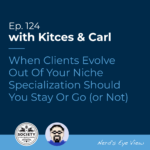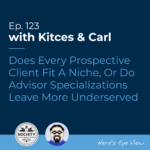
When a new year comes around it is often customary to set new personal and professional goals. Yet, in the midst of the tradeoffs that come with balancing new goals and their required behaviors, the challenge of creating sensible targets with flexibility and grace can be confounded by the reality of living in a world where uncertainty abounds and complex life situations are difficult (and sometimes even impossible) to map out.
In our 131st episode of Kitces & Carl, Michael Kitces and client communication expert Carl Richards discuss the value of setting goals even when our circumstances may seem overwhelmingly complex and uncertain (and even when we know that our goals will change); as doing so helps us clarify not only where we want to go and what we want to achieve, but also what our initial first steps need to be to get to the 'nearest local optimum' that will reveal new perspectives about our journey. Because developing these new perspectives, over time, are what often reveals the true direction we need to go to realize our most fulfilling success.
As a starting point, it's important to recognize the value of taking any initial step, as without that first step, getting past the myriad choices that face us can feel overwhelming and impossible. Furthermore, giving ourselves permission to shift gears and change goals instead of sticking to a rigid and unchanging blueprint for life can help us navigate and adapt to the complex environment that surrounds us. And by continually reassessing our roadmap as we take each step, we can course correct our path, adjust our goals as needed, and solve for the next nearest local optimum that we need to target to help us progress along our journey.
Accordingly, setting flexible goals and reassessing their relevance from time to time can help us make sense of the mystery that lies in the world around us while bringing clarity to the adjustments we need to make to stay on a path that continues to have meaning for us. As while setting goals can motivate people to take action to achieve the plans they make for themselves, the reality is that the sense of security that comes with having goals – which is often the source of the motivation it provides – can be based on a fleeting framework that is subject to change at any time. The question to ask ourselves as we reassess our goals, then, is if the steps we are taking continue to bring us closer to something we truly want, whether that involves improving the work we do and getting to what feels right for us, and/or aiming for better financial, emotional, or mental profits?
Ultimately, the point of having goals is to keep us moving in the right direction toward the growth and progress we want to achieve. When goals become too rigid, they can inhibit our momentum and keep us from recognizing the adjustments we need to make to stay true to our values and priorities as they inevitably change over time. Which means that keeping goals flexible and constantly assessing the steps needed to reach the finish line is crucial in crafting the most useful goals. And by following a path true to our values, continually assessing (and re-assessing) the direction we're moving, and adjusting the goals along the way, we can have confidence that the road we're traveling will continue to bring us closer to a meaningful and fulfilling future!











